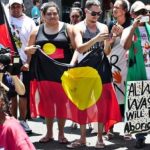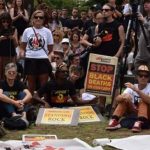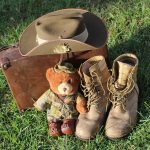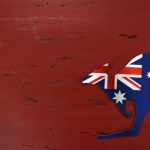Lest We Forget the Frontier Wars
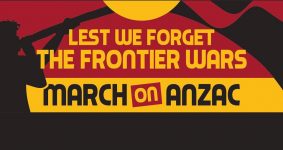
As Australians gather on April 25 to commemorate those who fell in conflicts on foreign soils, the nation still refuses to officially acknowledge the bloody conflicts that raged across this continent for close to a century and a half, known as the Frontier Wars.
In the days leading up to Anzac Day, the Frontier Wars Story Camp has been in operation in Canberra. In its fourth year, the story camp has the aim of raising awareness about the frontier conflicts and building support for the Lest We Forget the Frontier Wars March.
“We yearn for the day when the Australian War Memorial recognises the Frontier Wars as wars worthy of recognition and commemoration,” Arunta activist and camp convenor Chris Tomlins said. “With this recognition, reconciliation between the invaded and the invaders of this land can begin.”
The story camp, which began last Thursday, is being held at the Aboriginal Tent Embassy. This year marks the 46th anniversary of the embassy, which professor Gary Foley describes as “the most significant and successful Aboriginal political action of the entire 20th century.”
The forgotten wars
“The Frontier Wars are most devastating,” producer of the story camp Graeme Dunstan told Sydney Criminal Lawyers®. They were “the longest, the most people were killed and they effected the biggest change in society and landscape the continent had known in maybe 100,000 years.”
The long-term social activist explained that while 60,000 Australian soldiers were killed during the First World War, an estimated 65,000 First Nations peoples were killed during the frontier conflicts in Queensland alone.
The conflicts broke out on this continent just after the British began their armed takeover of the lands of Aboriginal nations and they continued on as late as 1934. They consisted of acts of Indigenous resistance, straight-out battles and indiscriminate massacres.
There were wars fought along the rivers now known as the Hawkesbury and Nepean that began in the 1790s. These included a 12-year guerrilla war fought against the British, which was led by renowned Bidjigal warrior Pemulwuy.
In 1824, the Wiradjuri people defended their land in the region now known as Bathurst. The genocidal Black War of Tasmania took place over 1824 to 1831. And the devastating Pinjarra massacre occurred in Western Australia in 1834, followed by the 1838 Myall Creek massacre in NSW.
Breaking the silence
The Frontier Wars were omitted from Australian history books from the late 19th century up until the 1960s. The Frontiers Wars Story Camp is about the ongoing breaking of this silence. Over the six days prior to Anzac Day, a series of storytelling sessions were held at the camp.
These sessions included Bunurong author Bruce Pascoe speaking about the destruction of Indigenous agriculture after British occupation, and Tom Baxter from the Kimberley region recalling the violence perpetrated upon First peoples during the making of WA’s Canning Stock Route.
And on Anzac Day itself, the Frontier Wars March will follow the same route as the Anzac Day March in Canberra for the eighth year in a row. The march honours those Aboriginal and Torres Strait Islander people who lost their lives fighting the British as they took over the continent.
In 2011, Aboriginal Tent Embassy co-founder Ghillar Michael Anderson initiated the annual march. He has said that the march highlights “the wars fought on Australian soil since 1788, when our country was taken by superior force at gunpoint, and those who stood in the way were shot.”
A couple of hundred participants are expected to take part in the Frontier Wars March this year. Mr Dunstan explained that while it continues to be warmly received by spectators, ACT police always turns the procession away from the Australian War Memorial (AWM).
A lack of recognition
A key aim of the both the Frontier Wars March and the camp is to have the AWM recognise “the wars of the British invasion of this land.” Mr Tomlins has explained that the “honest remembrance of the Frontier Wars is the gateway to reconciliation.”
However, AWM director Dr Brendan Nelson has reject the idea. In September 2013, he said that the memorial is concerned with wars that saw defence personnel deployed on behalf of Australia, “not with a war within Australia between colonial militia, British forces, and Indigenous Australians.”
Chair of the People’s Council of the Murrawarri Republic Fred Hooper questions this line of thinking. In April last year, Mr Hooper said that the memorial states it won’t recognise wars before federation. “But, there’s one war they recognise and celebrate pre-federation which is the Boer War.”
On Anzac Day 2015, Mr Hooper was stopped from laying a wreath at the AWM, as he’d been leading the Frontier Wars March. And the former Australian Navy submariner was also prevented from marching alongside the Submarine Association, as he was holding a Murrawarri Republic flag.
The Murrawarri Republic declared independence from Australia on March 30, 2013.
A matter of time
Mr Dunstan has told Dr Nelson in the past that Frontier Wars acknowledgement advocates have begun knocking on the AWM door and they “intend to keep on knocking” until it opens. And according to him, the “change is coming fast.”
The activist foresees the AWM putting “its resources behind researching and commemorating” the conflicts and making them a part of school curriculum. “It would be the end of the conspiracy of silence and the beginning of reconciliation with Australia’s black history,” he continued.
Dispelling the lies
The British began their occupation of this continent claiming terra nullius: the concept that the land had no owners. The Australian High Court overturned this legal fiction in its 1992 Mabo versus Queensland (No 2) ruling.
In acknowledging the Frontiers Wars, the nation would also be dispelling yet another long-propagated establishment myth: that of peaceful settlement.
“For us, it’s the recognition that this country was not peacefully settled,” Mr Hooper, who served six years in the Australian Navy, said just prior to Anzac Day last year. “They are saying this country was peacefully settled, but it wasn’t.”
“We fought the British. We fought the colonisers. And there were great warriors fighting all the way that aren’t being recognised in this country.”
The image was designed by UK-based Australian graphic designer Somerset Bean.


